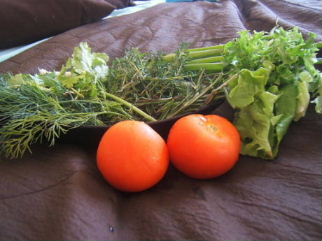|
Planting HerbsPlanting Herbs and growing your very own little herb garden can be very rewarding. I love everything about fresh herbs and therefore I love planting herbs.
Growing a Herb Garden
Most herbs grow well from cuttings, so whenever I can use cuttings over planting seeds, I will. I am not a very confident gardener - although I love pottering around, so I will always try the easiest way of doing things. Herbs like Lavender , Rosemary , Thyme , Marjoram , Oregano and mint all grow well from cuttings.
Planting Herbs
New tips make the best cuttings. Cut just below the leaf bud and keep your cuttings between layers of wet newspaper until you are ready to plant them.
If you don't like the idea of a separate herb garden then you can always add herbs to your existing garden. You can create beautiful and fragrant low hedges with a Rosemary plant and Lavender or use Thyme and Violets as groundcover in your garden.
The scent of certain herbs actually keeps certain insects away. For example coriander, anise and mustard planted between rows of vegetables like spinach and cherry tomatoes would not only protect them but also assist them to grow better. This is also referred to as companion planting. Harvesting Herbs
Harvest herb leaves when the plant starts flowering - at this stage in the plant's lifecycle, the herb's distinctive fragrance is most concentrated. Kitchen herbs can be harvested more frequently. The best picking time is early morning after the evening's dew has evaporated. Potted Herbs
Make sure
HANGING BASKETS Hanging baskets are good for creepers like Thyme and creeping Rosemary. Chives also look very attractive in a hanging basket. The only problem is that baskets dry out very quickly and therefore need regular thorough watering. WINDOW BOXES When planting herbs in your window box, try herbs like Thyme , Sweet Marjoram , Parsley , a small Rosemary bush , Chives and/or a little creeping Oregano plant. Make sure your box gets at least 8 hours of good sun and water your herbs regularly. Kitchen Herbs
Correct Potting Soil
3 parts peat 3 parts compost 1 part sand Watering your potted herbs
This is why it is so important to water your potted herbs at least once a day and in hot temperatures, even twice daily. The pot must never dry completely. Here's a good idea: Stand your herb container in a dish of water, so that the water is absorbed from the bottom but make sure the roots don't get water logged. Caring for your potted herbs
Add natural organic plant food to your potted herbs every two weeks for optimum plant health and growth. Good to know:
The difference between Perennial , Annual and Biennial Herbs
Other herbs only last for a season and germinate, flower, make seeds and die in one year. These are called annuals. Examples of annual herbs include Mustard, Linseed,
Basil
,
Marjoram
and
Paprika.
Examples of biennial herbs include Evening Primrose and Parsley. Don't you just LOVE your Frugal lifestyle? I certainly do! All this - growing your own vegetable garden, planting herbs,
green living
(all while you're also helping to save the planet!) and so much more is possible through this simple but fascinating lifestyle!
|






